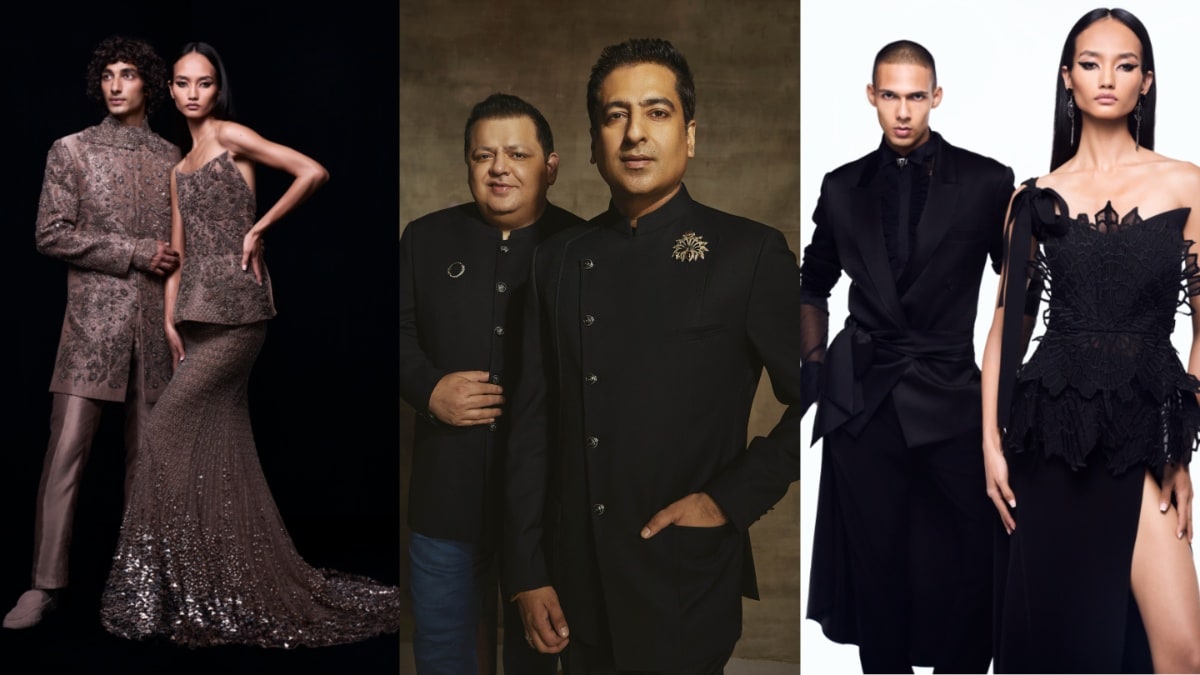In an EXCLUSIVE interview with Firstpost’s Lachmi Deb Roy for Fashion Police, celebrated designers Rohit Gandhi & Rahul Khanna talks on their autumn –winter collection, the story behind ‘Nocturnum’ and how sustainable is sustainable fashion.
read more
Rohit Gandhi and Rahul Khanna’s Nocturnum collection draws inspiration from the geometric patterns of meteors as they breach atmospheric barriers and descend on Earth as midnight blooms. The untamed beauty of these imaginary Roscharc wildflowers creates a sartorial universe that transcends time and space, evoking the majesty of a court ruled by night and stars.
Rahul Khanna also mentioned in the interview, sustainability of fashion is about considering the entire lifecycle of a garment. For the designer duo, the revival of traditional weaves is not just a trend; it’s a movement.
_Here is the edited excerpts from the interview
_
Tell us about your autumn-winter collection?
Our autumn-winter collection, Nocturnum, is a deep exploration of the interplay between geometry, nature, and architectural forms, all seen through the lens of the beautiful night sky. The collection captures the drama and mystery of the midnight sky and translates it into wearable art. The silhouettes are bold yet fluid, blending structured forms with softer, more organic shapes. This collection actually is a journey through an imagined landscape, where meteors transform into blooms, capturing a moment of celestial magic that is frozen in time. It’s about balance— balance between the hard and soft, the light and the dark, and the past and the future.
What is the fashion story that it conveys?
The story behind Nocturnum is one of cosmic transformation and timeless elegance. We’ve been inspired by the idea of meteors and the sky, and for this collection the stars bursting through the night sky and morphing into blooms became our poetic metaphor for change and evolution. This collection speaks to those who are unafraid to embrace their dualities and contrasts, merging the structured with the fluid and the geometric with the organic. It’s a reflection of how fashion can be both a protective armor and an expressive canvas, ready to capture the ever-changing nature of identity and personal style.
How sustainable is
sustainable clothing?
Sustainability in fashion is a multifaceted concept that goes beyond just using eco-friendly materials. It’s about considering the entire lifecycle of a garment—from the sourcing of raw materials to the craftsmanship, and finally, to the longevity of the piece in the consumer’s wardrobe. I think that true sustainability comes from creating pieces that are timeless and durable, both in terms of style and quality. Fashion is not just about what one wears; it’s about how you choose to wear it over time as well.
What do you have to say about the
revival of weaves?
The revival of traditional weaves is not just a trend; I think it’s a movement. It represents a return to our roots and a respect for the artisans who have kept these traditions alive through generations. Each weave tells a story, and as designers, it’s our responsibility to keep these stories alive while reimagining them for the modern world. We are committed to integrating these weaves into contemporary designs, ensuring they remain relevant and appreciated by future generations.
What are your views on handloom and vocal for local?
Handloom is the soul of our textile heritage—it’s where history, culture, and artistry converge. Supporting handloom and being vocal for local is about empowering communities and preserving craftsmanship that is often passed down through generations. It’s a way to sustain local economies and ensure that these skills don’t vanish in the face of industrialisation.
Your views on fashion pollution and what every individual can do to prevent it?
Fashion pollution is a pressing issue that needs collective action—from designers, brands, and consumers alike. As designers, we can reduce waste by choosing sustainable materials, creating versatile pieces that last longer, and promoting practices like upcycling and recycling. For individuals, it’s about being mindful of what you buy and how you wear it. Opt for quality over quantity, care for your clothes so they last longer, and support brands that prioritise ethical practices. Small changes in our purchasing habits can lead to significant positive impacts on the environment.

